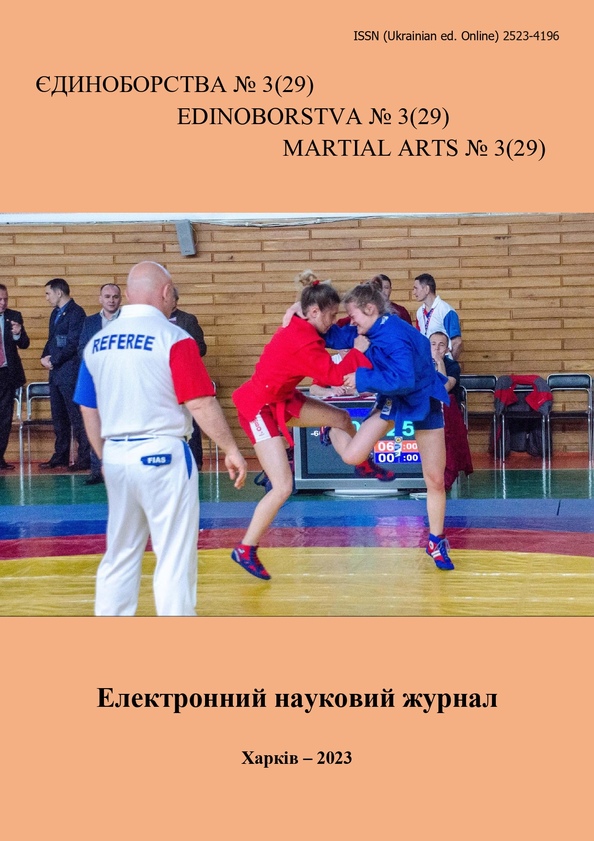Регресійні моделі спеціальної фізичної підготовленості тхеквондистів 12 14 років
DOI:
https://doi.org/10.15391/ed.2023-3.06Ключові слова:
тхеквондо, регресійні моделі, фізична підготовленість, технічна підготовленість, показник, модельні характеристики, прогнозуванняАнотація
Мета: розробити регресійні моделі спеціальної фізичної підготовленості тхеквондистів 12‑14 років. Матеріал та методи. Дослідження проводилось при громадській організації «Федерація тхеквондо (ВТФ) України». В ньому прийняли участь 30 спортсменів спеціалізації тхеквондо, віком 12-14 років, кваліфікація 1–2 дорослий розряд. В дослідженні використовувались наступні методи: теоретичний аналіз та узагальнення науково-методичної літератури та мережі Інтернет, педагогічне тестування, методи математичної статистики. Результати: встановлено, що показники спеціальної фізичної підготовленості, залежать від одної, двох, трьох й навіть чотирьох статистично значущих незалежних змінних (показників загальної фізичної підготовленості) у межах p< 0,05–0,01. З регресійних моделей видно, що статистично значущим на показник частота виконання бокових ударів ногами в тулуб за 10 с поперемінно обома ногами є швидкісно-силовий індекс, мах лівою ногою вперед за 15 с та «Пістолет» на ліву ногу за 30 с. Встановлено, що на показник боковий удар з розворотом в протилежні напрямки за 15 с в верхній рівень залежить від повздовжнього шпагату на ліву та праву ноги. Боковий удар з розворотом на 360° за 15 с лівою та правою ногами залежить від маху лівою ногою вперед за 15 с та на показник правої ноги ще впливає швидкісно-силовий індекс. Показник зворотнього бокового удару за 15 с правою ногою статистично залежить від поздовжнього шпагату на ліву ногу. Максимальна кількість ударів nerio chagi поперемінно за 15 с залежить від чотирьох показників спеціальної фізичної підготовленості: поздовжніх шпагатів на праву та ліву ноги, маху лівою ногою за 15 с і «пістолету» на праву ногу за 30 с. Висновки. В сучасних умовах підготовки спортсменів на етапах багаторічної підготовки для прогнозування успішності, фахівцями в галузі фізичної культури та спорту широко використовується побудова регресійних моделей підготовленості. Для експрес побудування регресійних моделей будь-якого порядку необхідно застосовувати лінійні регресійні моделі з однією незалежною змінною. Для деталізації процесу прогнозування необхідно застосовувати множинний аналіз з покроковим методом, який дозволить ув'язувати в регресійне рівняння незалежні змінні, що мають найбільші коефіцієнти часткової кореляції із залежною змінною. Дослідженнями встановлено, що у тхеквондистів 12-14 років статистично значущим показником фізичної підготовленості, який впливає на прояв спеціальної, є поздовжній шпагат на ліву та праву ноги але захоплення розвитком гнучкості спортсменів може привести до погіршення результатів швидкісно-силової спрямованості.
Посилання
Бабак, Ю.М., Константинова, Е.А., Волкова, Ю.А., Пашков, И.Н., & Мутьев, А.В. (2010). Тхэквондо: Методика построения тренировочного процесса в начальных и учебно-тренировочных группах. Киев.
Бачинська, Н. В., & Кощєєв, О. С. (2010). Контроль загальної та спеціальної фізичної підготовленості тхеквондистів 12–13 років. Педагогіка, психологія та медико-біологічні проблеми фізичного виховання і спорту, № 1, 6–9. https://sportpedagogy.org.ua/html/journal/2010-01/10bmvsyt.pdf
Бойченко, Н.В. (2018). Прогнозирование технического мастерства единоборцев 15-16 лет. Єдиноборства, №4(10), 4–12.
Єрмаков, С.С. (2010). Біомеханічні моделі ударних рухів у спортивних іграх у контексті вдосконалення технічної підготовки спортсменів. Теорія та методика фізичного виховання і спорту, №4, 11–18.
Козина, Ж.Л. (2009). Нелинейные регрессионные модели индивидуальных закономерностей динамики соревновательной эффективности в баскетболе. Теорія та методика фізичного виховання і спорту, №7, 35–39.
Панов, П.П., & Тропін, Ю.М. (2019). Модельні характеристики фізичної підготовленості кваліфікованих спортсменів-рукопашників. Єдиноборства, №3 (13), 35–41. DOI:10.15391/ed.2019-3.05
Пашков, И.Н. (2007). Модельные характеристики специальной физической подготовленности тхеквондистов 12-14 лет. Слобожанський науково-спортивний вісник, №11, 79-82.
Пашков, И.Н. (2017). Основы построения модельных характеристик в тхеквондо. Єдиноборства, №3, 59–61.
Пашков, І., & Кєрімов, Ф. (2023). Теоретичні та практичні основи тренувальної діяльності в тхеквондо. Проблеми і перспективи розвитку спортивних ігор та одноборств у закладах вищої освіти, 39–43. http://journals.uran.ua/pprsievnz/article/download/273319/268767
Пашков, І., & Пироженко, О. (2023). Кореляційні взаємозв’язки спеціальної фізичної та технічної підготовленості тхеквондистів. Єдиноборства, № 1 (27), 39-48. http://journals.uran.ua/martial_arts/article/download/274101/269306/631571
Пашков, І.М., & Кощеєв, О.С. (2022). Тхеквондо ВТФ. Навчальна програма для дитячо-юнацьких спортивних шкіл, шкіл вищої спортивної майстерності, закладів спеціалізованої освіти спортивного профілю із специфічними умовами навчання. Міністерства молоді та спорту України. Київ.
Пашкова, В., & Пашков, І. (2023). Особливості фізичної підготовки тхеквондистів 15-17 років. Проблеми і перспективи розвитку спортивних ігор та одноборств у закладах вищої освіти. 44–48. http://journals.uran.ua/pprsievnz/article/download/273320/268768.
Платонов, В.М. (2020). Сучасна система спортивного тренування. Перша друкарня, Київ.
Подрігало, О., Борисова, О., & Подрігало, Л. (2021). Обґрунтування та аналіз концептуальної моделі прогнозу успішності спортсменів єдиноборств на етапах базової підготовки. Теорія та методика фізичного виховання і спорту, №1, 3–8. DOI:10.32652/tmfvs.2021.1.3–8
Подрігало, О.О., Подрігало, Л.В., & Сокіл, К.М. (2019). Використання методик прогнозу в моніторингу стану юних спортсменів. Охорона здоров’я дітей та підлітків, № 2, 84-86.
Ровный, А.С., Романенко, В.В., & Пашков, И.Н. (2013). Управление подготовкой тхеквондистов : монография. Харьков.
Ровный, А.С., Галимский, В.А., & Бойченко, Н.В. (2016). Физическая и технико-тактическая подготовка каратистов (киокушинкай) на этапе предварительной базовой подготовки : монография. ХНАДУ, Харьков.
Романенко, В.В. (2007). Построение биомеханических моделей основных технических приёмов выполняемых ногами для таэквондистов-новичков. Слобожанський науково-спортивний вісник, №12, 281-285.
Романенко, В.В., & Веретельникова, Н.А. (2019). Повышение эффективности тренировочного процесса юных таэквондистов на основе анализа их подготовленности. Єдиноборства, № 1 (11), 63-70. https://core.ac.uk/download/pdf/235299503.pdf
Романенко, В.В., & Ровный, А.С. (2009). Взаимосвязь технической и физической подготовленности юных таэквондистов. Слобожанский науково-спортивний вісник, №3, 72-78. https://www.researchgate.net/profile/Vyacheslav-Romanenko/publication/310033261_Vzaimosvaz_tehniceskoj_i_fiziceskoj_podgotovlennosti_unyh_taekvovondistov/links/5828380408aecfd7b8c37e20/Vzaimosvaz-tehniceskoj-i-fiziceskoj-podgotovlennosti-unyh-taekvovondistov.pdf
Савченко, В.Г., & Лукіна, О.В. (2016). Провідні компоненти фізичної та технічної підготовленості юних спортсменів-єдиноборців. Спортивний вісник Придніпров‘я, №1, 111–116. http://infiz.dp.ua/misc-documents/2016-01/2016-01-18.pdf.
Тропін, Ю.М., Романенко, В.В., & Латишев, М.В. (2021). Взаємозв’язок рівня прояву сенсомоторних реакцій з показниками фізичною підготовленістю у юних таеквондистів. Єдиноборства, 2(20), 93-104. DOI:10.15391/ed.2021-2.08.
Pervachuk, R., Tropin, Y., Romanenko, V., & Chuev, A. (2017). Model characteristics of sensorimotor reactions and specific perceptions of trained wrestlers. Slobozhanskyi herald of science and sport, № 5 (61), 72-74. http://journals.uran.ua/sport_herald/article/download/116228/pdf_217
Rovniy A., Pasko V., Karpets L., Lyzogub V., Romanenko V., Pashkov I., Dzhym V., & Dzhym Y. (2018). Optimization of physical loads as a basis for formation of the coordination features of young taekvondo athletes. Research journal of pharmaceutical biological and chemical sciences, № 9(5), P. 2216–2225. https://www.rjpbcs.com/pdf/2018_9(5)/[281].pdf
Tropin, Y., Korobeynikov, G., Curby, D., Vorontsov, A., & Shatskih, V. (2019). Model characteristics of sensorimotor reactions and specific perceptions of wrestlers among different weight categories. International Journal of Wrestling Science, 2, 14-17.













